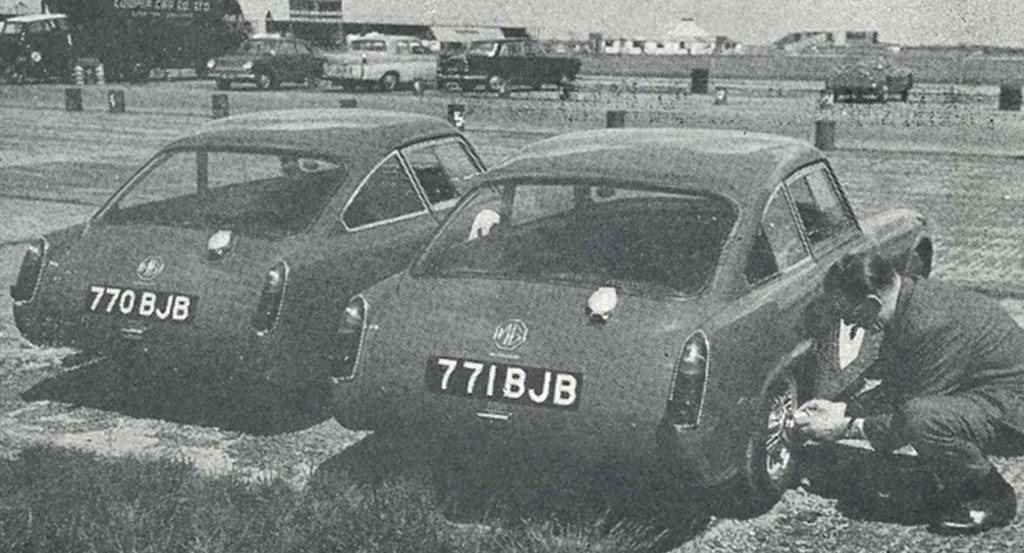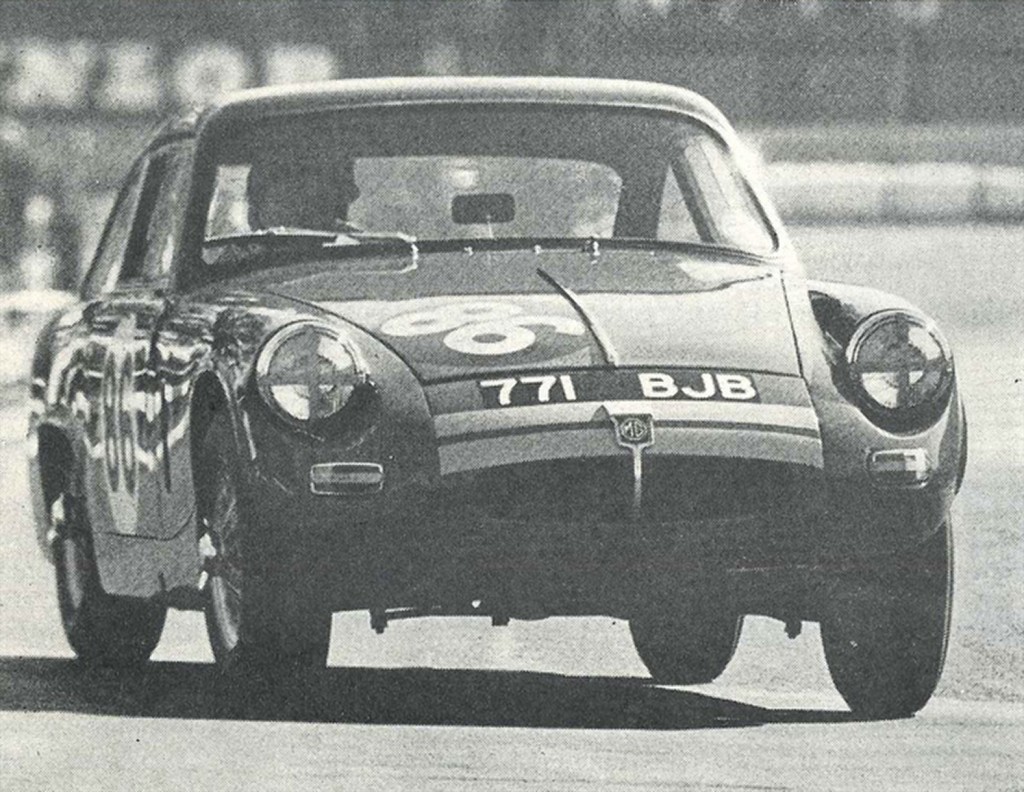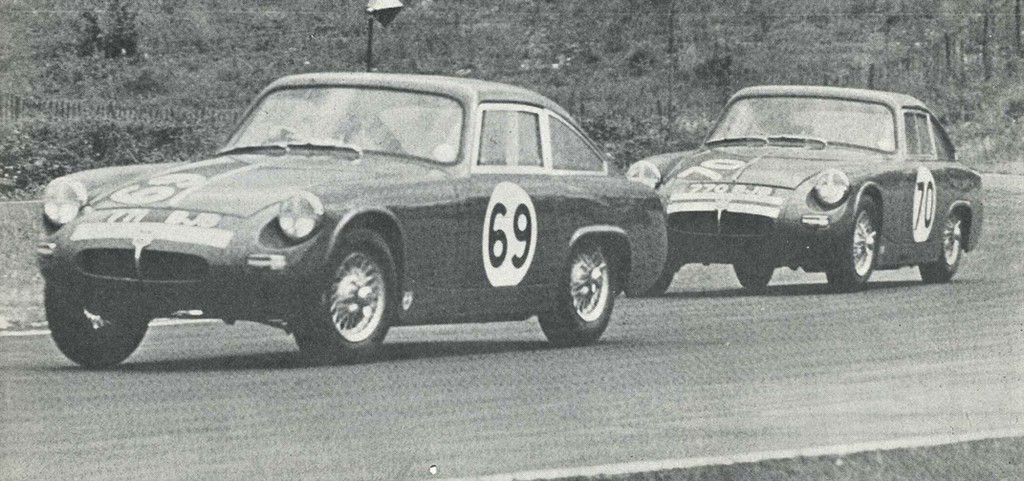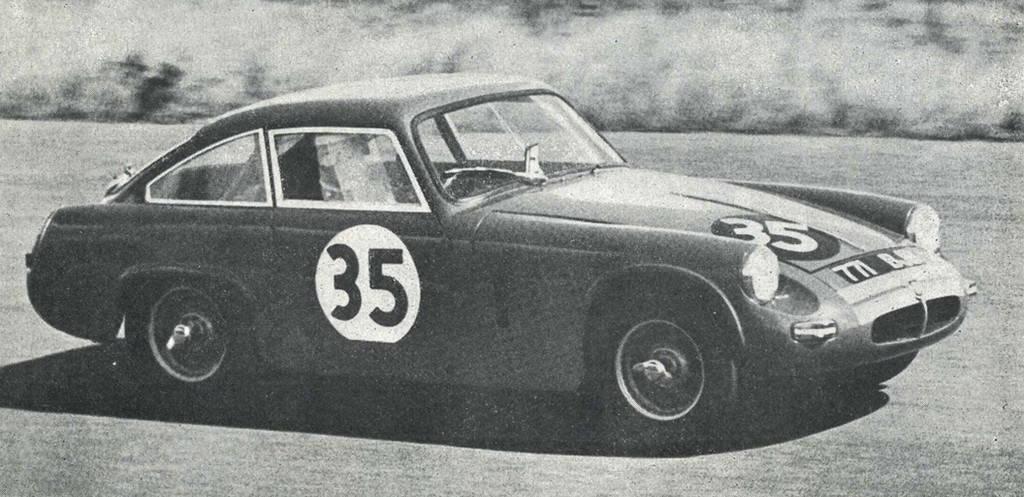Dick Jacobs and the Mighty Midgets
Reproduction in whole or in part of any article published on this website is prohibited without written permission of The MG Car Club.
The following feature comes courtesy of Safety Fast! from February 1965, and looks at the success that legendary Race Driver/Team Manager Dick Jacobs had with his MG Midgets on the international stage. Written by Peter Browning.
Last season Dick Jacobs announced his retirement from racing, bringing to a close 27 years of racing MGs both as a driver and team manager. This is the story of the most successful Jacobs Teams of all…
Talk of post-war racing MGs and you are bound to mention the name of Dick Jacobs. Ever since he bought his first Midget in 1937, Dick has been driving behind the octagon, owning at least one example of every Midget ever built and a whole host of other MGs besides. Racing has always been a part of Dick’s life, and of the post-war MG models he has successfully raced the TC, TD, YB, ZA and MGA.
Unhappily, Dick’s racing career as a driver came to an end in 1955, when his works prototype MGA overturned at Le Mans and he received grave injuries. After a long convalescence Dick, now aged 40, decided that the time had come to hang up his crash hat; after all, he did have a flourishing MG Distributorship to look after in north London.
But with motor racing in your blood it is terribly hard to cut yourself off from the sport. With Dick’s knowledge and love of the sport, team management was the natural outlet for his continued enthusiasm for racing MGs. He began in quite a small way by preparing and managing a privately owned MGA during the 1957 season.
 Silverstone 1963. Dick Jacobs makes a final check on tyre pressures before the International Trophy Race
Silverstone 1963. Dick Jacobs makes a final check on tyre pressures before the International Trophy Race
The next year he ran a couple of Magnettes, one of which won its class in the BRSCC Saloon Car Championship. Next came that well-known pair of pale green MGA Twin-Cams which established the Jacobs’ tradition for reliability. In two years of busy competition only twice did the fantastically quick Twin-Cams fail to cross the finishing line – once with a puncture and once with dirty fuel!
Then came the new MG Midget, which Dick considered was a potential class winner in the field of international GT and production sports car racing. As a result of Jacobs’ enthusiasm and Abingdon know-how it was not very long before the team acquired a very special pair of almond green Midget coupes.
The now very familiar lines of the Jacobs’ Midgets was no flash of the stylist’s pen, but a highly efficient, wind-tunnel-tested design. Indeed, the streamlined shape and light weight alone contributed much to the Midgets’ performance, for some 13bhp less was required to propel the little cars along at 100mph than the standard Midget body shape.
The pretty coupe body was built upon a standard Midget chassis platform using hand-beaten aluminum panels made to the standard wing, door, and side panel shapes, extended to blend into the fixed hardtop and streamlined body section. To produce an exceptionally rigid and rattle-free join between steel sub-frame and aluminum body panels, new construction methods were applied with the use of Araldite epoxy resin adhesive.
Ready for the starting grid the Midgets turned the scales at 1,242 lb., 324 lb. lighter than the standard car. The standard Midget suspension was modified for racing with a heavier duty anti-roll bar at the front with stiffer Armstrong damper settings. At the rear, adjustable Armstrong dampers were fitted, and there were softer-rate rear springs re-cambered to suit the lighter load.
The standard bump rubbers were replaced with Aeon progressive-type, standard equipment on early MGBs. Lockheed disc brakes were used at the front with drums at the rear. Dunlop wire wheels were fitted with 5.25-13 racing tyres at the rear, 4.50-13 at the front.
The engine, of course, was the faithful A-type modified just as far as the Group-3 regulations permitted. In their early days the Midgets ran with the 948cc unit bored out the maximum permitted .040 in. oversize, bringing the capacity to 972cc. This produced a power output of around 75bhp.
 Alan Foster swings the Midget out of the hairpin at the Mallory Park International Meeting, Whitsun, 1963
Alan Foster swings the Midget out of the hairpin at the Mallory Park International Meeting, Whitsun, 1963
A single 45DCOE Weber carburetor was used, and there was a special camshaft, inlet and exhaust manifolds, and modified head giving raised compression. Later in the Midgets’ racing career a little more power was coaxed from the A-series by boring out still further to 995cc; then, when the 1098cc engine was introduced, this was fitted to the Jacobs’ cars in 1139cc form.
Finally, when the 1275cc unit was homologated at the end of 1963, this was raced in the Midgets in 1293cc form. During the past season one of the cars was converted to dry-sump lubrication, which gave a slight increase in power (due to less oil-drag) and, although the oil consumption remained the same, it meant that the engine could run longer without topping up – very important in long-distance races.
Transmission was via a competition Borg and Beck diaphragm clutch to a close-ratio gearbox. A variety of rear axle ratios were used to suit different circuits; with the normal 4.55 ratio the Midgets ran at 15.4mph per 1,000rpm. With the original 972cc motor the Midgets’ terminal velocity was timed at 119.5mph at 7,750 rpm. And that’s quite a lot of mph from just 1 litre!
In the interests of lightness the interior of the Midgets was Spartan compared with the standard car, but everything was beautifully tailored to the essential needs of the racing driver: raked bucket seat, black crackle dashboard, small wood-rim steering wheel, big-size rev-counter.
Typical Jacobs’ touch was the cleverly designed door catch which extended up through to the top of the door and which needed only a quick downwards strike through the open side screen to open the door. Just the job for a brisk Le Mans start!
So much for the technical talk; how did the Jacobs’ Midgets fare on the racetrack? Well, as everyone knows, the cars built up a truly formidable record and this is going to be one of the dullest competition case histories ever written!
There is not much you can say when the cars just go on winning their class time and time again with monotonous regularity. It was a major disaster if a Jacobs’ Midget failed to finish a race!
Take for instance, Dick’s first season with the Midgets; actually only a half season, for he took over the cars in the summer of 1962. In the 10 events entered, which represented 22 individual car entries, the Midgets were placed in the first four places 13 times. In the two most important events, the Brands Hatch August International (full circuit) and the Snetterton Three Hours, the little green Midgets romped home 1st and 2nd in the class. Of the 22 starts, not once did the MGs fail to finish; a pretty encouraging start for the first season.
The story was much the same in 1963. The two Midgets contested 14 GT races, all of them national and international status where there was stiff opposition. In some events the Midgets were obliged to run in the 1300cc or even the 2-litre class. This year the Jacobs’ team finished in the first four places on 20 occasions.
Significant class victories were claimed at the International Snetterton sports car race in March, the International BARC Easter Goodwood Meeting, the British Grand Prix Meeting at Silverstone, and the August International at Brands Hatch. The season closed with a class win in the Autosport Championship.
Then onto last season’s success list. Eleven events entered (again all the big-time Internationals and Nationals), with places in the first three no fewer than 15 times. This included a repeat class win in the BARC Easter Goodwood International, and other class victories at the International BRDC Trophy Meeting at Silverstone, the British Grand Prix Meeting at Brands Hatch, and the Snetteron Three Hours.
But perhaps the Midgets’ greatest run ever was in the International 1000km sports car race at the Nurburgring, when the Jacobs’ team brought home a 1-2 class win and finished as the highest-placed British car, defeating a really tough field of British and continental sports racing machinery. Returning to the ‘Ring’ later in the year for the 500km race, the Midgets, although robbed of class victory this time, again took the chequered flag as the highest-placed British entry.
 Andrew Hedges and Alan Foster hold the immaculate Midgets in tight formation, a sight which will be sadly missed around the circuits this season now that the Jacobs Team is disbanded
Andrew Hedges and Alan Foster hold the immaculate Midgets in tight formation, a sight which will be sadly missed around the circuits this season now that the Jacobs Team is disbanded
So far we have not mentioned the all-important drivers who have so consistently brought the Midgets to the finishing line. Alan Foster was the first to join the Jacobs’ team; Alan has now been driving against, with, and for Dick Jacobs for some 12 years. Foster introduced Olympic bob-sleigh man, Andrew Hedges, to the team and together they made the perfect pair; the fiery Hedges always happy to be out in the front wearing down the opposition while the steadier Foster sat back and waited for the opposition the blow up and/or Hedges to go off the road!
The opposition usually did blow up and, after his first season with the team, Hedges managed to stay on the road pretty frequently too! When the two Midgets were entered for long-distance races and four drivers were required, Keith Greene and Chris Martyn joined the team. Both drive extremely well, Greene partnering Hedges and Martyn driving with Foster to bring home the team’s major 1-2 class win the 1000km race at the Nurburgring.
Mention must be made of the Jacobs’ sideline effort with the MG 1100 in The Motor Six-Hour Saloon Car Races at Brands Hatch. Dick took delivery of one of the first 1100s to appear, and when it was only four days old entered it for The Motor Six-Hours. The MG won its class and, when the same car was entered in the 1963 event, it finished 4th in class, only giving best to three Mini-Cooper S’.
It was indeed very sad to hear the news at the end of last season that Dick Jacobs had announced that the team was to be disbanded. And yet this was not altogether unexpected. The Midgets had enjoyed three tremendously successful seasons; nothing more could have been asked from cars or drivers.
There was, indeed, little more for the Midgets to win, for in only three seasons the little MGs had been placed amongst the first four no fewer than 45 times. It was practically unknown for one of the cars to retire; indeed the team’s only disaster was when a mechanic drove the transporter under a low bridge at Snetterton and shoveled the topmost Midget off its perch in the van!
The little green Midgets will be sadly missed on the racing circuits this season, as will the friendly figure of Dick Jacobs, always ready to give advice and a helping hand to his rivals. Dick has always directed any praise firstly to his drivers, mechanics, timekeepers, and everyone who has helped to make this success story.
If Dick were telling this story we feel that this is the way he would bring it to a close. That’s the way we will close it too. P.W.B.

 MG Car Club
MG Car Club


